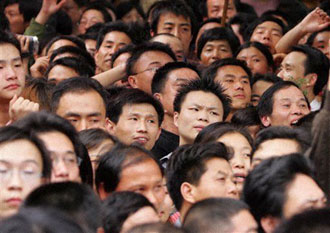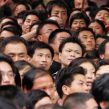
2010 Census Exposes Fault Lines in China’s Demographic Shifts
Publication: China Brief Volume: 11 Issue: 8

The just-published results of the People’s Republic of China (PRC) 2010 Census have shown that just like any other country, the Middle Kingdom has to contend with the sobering limitations of demographics. Perhaps the only good news among the barrage of statistics is that at an average growth rate of 0.57 percent a year, the population was expanding in the 2000s at a markedly slower pace than the 1.07 percent recorded in the previous decade. There were 1.34 billion Chinese as of 2010, up from 1.27 billion in 2000 (Xinhua News Agency, April 28; Wall Street Journal, April 29). Yet the populace is graying faster than expected even as the number of young men and women entering the job force will start declining soon. While the Chinese Communist Party (CCP) administration launched an ambitious "develop the West" program in the late 1990s, one of whose goals is to create more working opportunities for residents in the heartland regions, the speed of migration to the already overcrowded eastern "Gold Coast" has picked up dramatically. Moreover, the size of the national migrant population has reached more than 200 million. Since these "floating" masses of mostly rural-based workers are not allowed to acquire permanent residence status in the cities, they are barred from labor and social-welfare benefits reserved for urban residents. Chronic exploitation of this huge "underclass" by factory owners as well as municipal officials has spawned massive grievances and undermined social stability.
Fast-shifting demographic trends have had the biggest impact on the nation’s socio-economic development. The latest findings confirm the now oft-repeated adage that "China is becoming old before it becomes rich." China’s demographic dividend—a reference to speedy economic expansion due to an increase of the proportion of Chinese who are working—is forecast by official economists to decline sharply from around 2013. And by 2039, less than two Chinese taxpayers may have to look after one retiree (Xinhua News Agency, May 3; Global Times, September 9, 2010). The census shows that people over 60 years of age account for 13.26 percent of the populace, compared to 10.33 percent in 2000. By 2040, this figure is projected to spike to a stunning 28 percent. In an authoritative study published late last year, the Chinese Academy of Social Sciences (CASS) forecast that by 2030, the proportion of the population that is over 65 will exceed even that of Japan, which has the grayest population in Asia. "By 2050, Chinese society will enter into a phase of severe agedness," CASS indicated (Sina.com, April 29; China News Service, September 11, 2010; Global Times, September 12, 2010). A major theme of the 12th Five-year Plan on Economic and Social Development is boosting social-welfare benefits, including those for senior citizens. Yet, it is doubtful whether adequate resources can be provided particularly for old rural residents, who traditionally rely on their children and grandchildren to take care of post-retirement needs (See "Beijing’s Blueprint for Tackling Mass Incidents and Social Management, China Brief, March 25).
The flip side of the coin is that labor shortages, which first became acute in booming hubs of the "World Factory" such as the Pearl River Delta and the Greater Shanghai Region in early 2010, will become more pronounced across China. The census reveals that the country’s future workers—Chinese under 14—make up only 16.6 percent of the population, down from 23 percent ten years ago. Spokesman of the State Statistical Bureau Ma Jiantang indicated that total pool of potential workers—a reference to Chinese aged between 16 to 59—reached 921.48 million last year. Yet this cohort is expected to start declining from 2013 onward (MSN.com, April 29; New Beijing Post, April 29). According to Zhong Dajun, head of an economic consultancy in Beijing, at least 10 million new blue-collar workers entered the labor force annually in the mid-to-late 1990s. "Now, this number is down to about 5 million or so," he said. "After five or six years, new entrants to the labor market may dwindle to a mere one to two million a year." The situation is likely to worsen, particularly given President Hu Jintao’s recent statement that China would not consider abolishing its much-criticized one-child-family policy (Reuters, April 29; China Youth Daily, February 14; Global Times, February 14).
The rash of labor incidents in southern China early last year—including protests in the Chinese units of famous multinationals such as Foxconn and Honda—illustrated that the new generation of workers are much less willing to tolerate harsh terms and conditions than their forebears. The CCP leadership was even forced to acquiesce to Guangdong workers adopting some form of collective-bargaining tactics to improve their wages and working environment (China-labor.org, June 9, 2010; Wall Street Journal, June 14, 2010). As the labor shortage became more severe, 12 provinces and major cities raised their minimum wage in the first quarter of this year. The increase rate was a whopping 20 percent or more in half of these regions. It is expected that as their bargaining positions continue to improve over the years, Chinese workers may clamor for the right to set up free trade unions, which Beijing deems potentially subversive (Xinhua News Agency, April 5; Apple Daily [Hong Kong] May 3).
Indeed, fresh census figures have highlighted the growing political pressure that Beijing faces on different fronts. Foremost is the dramatic increase in the size of the "floating population"—a reference to people who live apart from their domicile as defined by China’s stringent hukou or household registration system, which mushroomed from 144 million in 2000 to 261 million last year. Most of these are migrant workers from the heartland provinces who seek opportunities in manufacturing centers such as Guangdong and Shanghai. Under the hukou system, however, these rural work hands cannot get urban ID cards, and they are barred from social-welfare benefits ranging from education to health and retirement. Last year, 15 Chinese newspapers ran a joint editorial calling on Beijing to immediately scrap the "inhumane" hukou system. Despite Premier Wen Jiabao’s repeated pledges about boosting "social equality and justice," the central government has refused to budge (Financial Times, March 4, 2010; People’s Daily, March 6). Thanks to the labor shortage, however, migrant workers may feel emboldened to demand a speedier end to the hukou system, which violates the Chinese Constitution.
Yet the relentless migration of the populace to the eastern "Gold Coast" may convince the CCP administration that throwing out the hukou regime could lead to more overcrowding in already very populous cities ranging from Beijing and Tianjin to Shanghai and Shenzhen. Through the 2000s, the eastern coast’s share of the population increased by 2.41 percent to reach 37.98 percent, while that of the western and central regions declined respectively by 1.11 percent and 1.08 percent to reach 27.04 percent and 26.76 percent. With 104.30 million people, Guangdong is now the country’s most populous province. That honor used to belong to Henan. With 94.02 million people, the central province has dropped to No. 3, behind coastal Shandong, which boasts a populace of 95.79 million. Pleading that their health, education and social-welfare facilities are stretched to the limit, coastal cadres have vigorously opposed allowing more migrant workers to settle in the east (Beijing Morning News, April 30; Shandong Business News, April 30; Ming Pao [Hong Kong], April 29).
Seen from another perspective, the relentless eastward-migration trend represents a failure of the CCP leadership’s much-ballyhooed "go west" program, which was started in the late 1990s by the administration of former President Jiang Zemin. A central plank of the Hu-Wen team’s "scientific theory of development" is specifically shrinking the gap between eastern and western China. Not only workers but highly educated engineers, entrepreneurs, professors and IT personnel are leaving the relatively poor western provinces for the larger paychecks and glamorous lifestyles of the coast. This migration fad also shows that Beijing has yet to make progress against the country’s fast-deteriorating environment, particularly desertification. Hardest hit are poor and dry provinces such as Ningxia and Qinghai, whose populations have shrunken to respectively 6.30 million and 5.63 million in the past decade (The Guardian, January 4; Sina.com, April 30).
In an article last month in the Global Times, an offshoot of the People’s Daily, veteran commentator Shan Renping repeated the CCP’s standard line that one-person-one-vote elections and "Western-style democratic politics" are not suitable for China. "China being a complicated and large country, a strong and forceful central government is absolutely necessary for unity and stability," Shan asserted. Furthermore, in his address to the National People’s Congress earlier this year, parliamentary chief and Politburo Standing Committee member Wu Bangguo reiterated that the CCP would never adopt a "multi-party revolving-door system or other Western-style political models." Otherwise, he warned, the country "could sink into the abyss of internal disorder" (Global Times, April 22; BBC News, March 11; China Daily, March 11). The census, however, has demonstrated that China has acquired all the socio-economic criteria that precipitated the development of "Western" political institutions in countries and regions ranging from South Korea and Taiwan to the Philippines, Malaysia and Indonesia. The recent flare-up of "people power" in numerous countries in the Middle East and North Africa has further demonstrated that the desire for ending one-party dictatorships—and adopting democratic institutions such as popular elections—is universal.
According to the census, the proportion of college-educated Chinese went up from 3.61 percent in 2000 to 8.93 percent last year. 49.68 percent of the population lives in the cities—and the great majority of urban residents have access to the Internet. Moreover, per capita GDP reached a respectable $4,300 last year (Ming Pao, April 30; Huanqiu.com, April 29). Irrespective of apparent spin-doctoring by official commentators about the superiority of the "China model," more Chinese professionals and entrepreneurs than ever are settling abroad, partly due to dissatisfaction with their home country’s rigid political system (See "China’s Brain Drain Dilemma: Elite Emigration," China Brief, August 5, 2010). Latest polls in China show that at least 60 percent of residents in upper-income brackets had either completed procedures for emigration to Western countries or were about to do so (Huanqiu.com, April 23; Global Times, April 26). Should the CCP leadership continue to drag its feet on political liberalization, more elite members among denizens of the coast may emigrate to the United States, Canada and Europe, even as well-trained talents from central and western regions flock to the eastern metropolises.
There are officials and academics who see fast-changing population trends as an opportunity rather than a threat. The decline in the supply of workers may harden Beijing’s resolve to go high-tech. For example, Mo Rong, a senior researcher of the Ministry of Human Resources and Social Security, indicated that "the labor shortage will force enterprises to go after an innovation and technology-driven strategy." A central thrust of the 12th Five-Year Plan is to restructure the economy by sidelining labor-intensive "sunset" industries and emphasizing cutting-edge sectors such as IT and bio-technology that demand much fewer workers (China Daily, May 3; Xinhua News Agency, March 17). The success of this strategy, however, presupposes that the nation can metamorphose from "world factory" to "global innovative hub" within record time. Moreover, the graying of the population could become such a drain on the resources of most Chinese families that another seminal economic goal for the 2020s and 2030s—boosting consumer spending—may be jeopardized. A decline in economic growth—seen as the prime basis of the CCP’s legitimacy—could prompt more challenges to the party-and-state apparatus particularly given its repeated refusal to entertain political liberalization.





